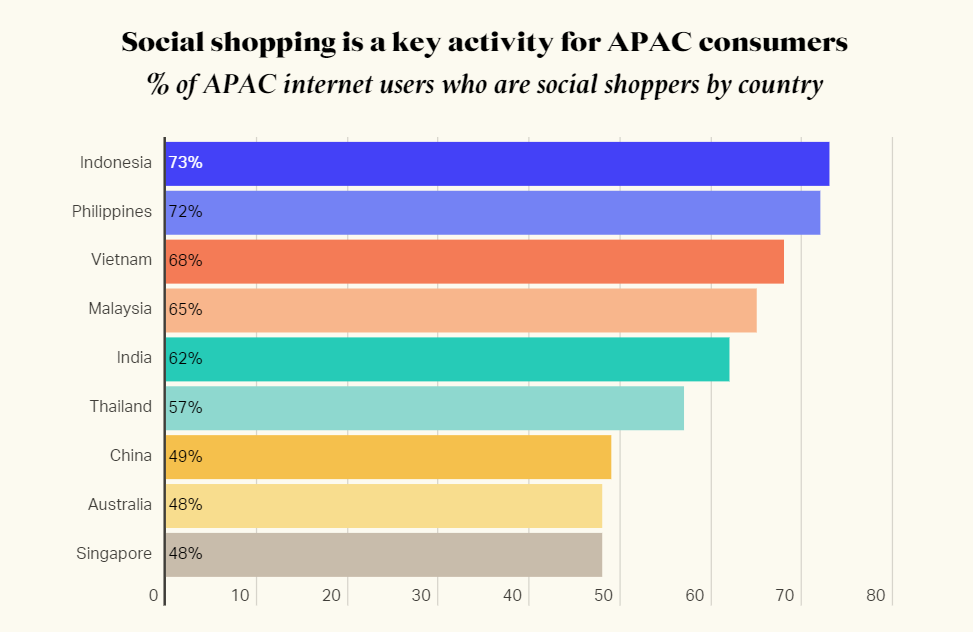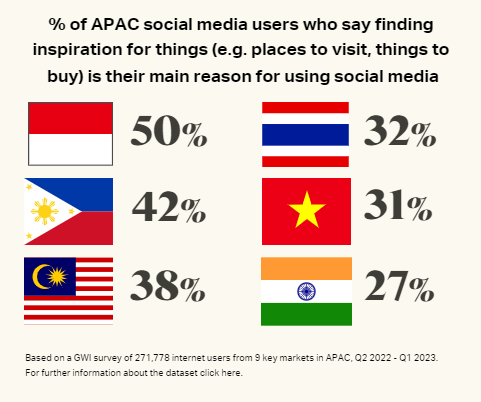Examining the region’s social commerce path to purchase will give marketers insight into how brands can reach audiences in their chosen environments, says WARC’s Stephanie Siew. This is part of the APAC spotlight on social commerce and examines consumer data from ongoing surveys of Asia Pacific internet users, provided by GWI and supported by knowledge and opinion from industry experts.
This article is part of a Spotlight series on social commerce in APAC. Read more
APAC has long been regarded as a social media-savvy region, accounting for more than half of the world’s active social media users. The average APAC consumer spends more than two hours per day on social media; this number rises to over four hours in the Philippines and three hours in Indonesia and Malaysia. Southeast Asia, in particular, has extremely high levels of social media engagement, with an overwhelming 90% of internet users having signed up on social platforms such as Facebook, Instagram and WhatsApp.
The heavy consumption of social media in APAC is no longer a new phenomenon but what’s changed is the way it is used in this region. Modern use cases for these platforms go beyond just social connection and have extended far into the realm of online commerce. Today, over half (55%) of internet users in APAC are social shoppers, i.e. those who either:
- discover brands via ads seen on social media,
- look for information about products on social media, or
- are motivated to make an online purchase by the option to use a “buy” button on a social network

Social commerce, which combines social media platforms with e-commerce functionalities, has become a popular way to shop online. A closer look at the social commerce path to purchase might give marketers insight into how it can help brands reach audiences in their chosen environments.
Breaking down the social commerce path to purchase
APAC’s appetite for social commerce is driven in large part by the convenient and seamless experience that it delivers across the purchase journey. Through social media, an already massive pool of potential buyers is able to discover, research and purchase products – all within the same social media platform.
At the discovery stage: A quarter (25%) of APAC internet users say they typically find out about new brands and products through ads seen on social media – a proportion comparable to discovery through ads seen on TV (27%) and search engines (27%). A similar number (23%) say the same about recommendations/comments on social media.
The role of social media at this stage is even more prominent in Southeast Asia. A recent study by Bain and Meta (2022) revealed that nearly half (46%) of Southeast Asian respondents cited social media and messaging platforms as the top channel for browsing and finding items. Video on social media alone accounted for 21% of all online discovery in this region.
Discovery and inspiration are key motivators driving social media usage, especially in countries such as Indonesia and the Philippines where approximately half of users say finding inspiration for things is their main reason for using social media.

At the evaluation stage: Two in five (41%) APAC internet users say they mainly use social networks when researching brands and products. However, differences exist within the region. Internet users in Indonesia (63%), Vietnam (59%) and the Philippines (56%) are substantially more likely to rely on social networks for their research compared to countries such as Singapore (34%) and Australia (34%).

Social proof, or the tendency to defer to the behaviours of other people, can be especially powerful in Asia’s collectivist cultural context. Analysis by Bain and Meta (2022) shows that social factors such as online word of mouth and influencer social media posts are among the three biggest sources of influence on brand or product consideration.
At the purchase stage: Some social media features can incentivise purchase decisions. In China, for example, two in five (39%) say that having a “buy” button on the social network would increase their likelihood of buying a product when shopping online. Indonesia and the Philippines, in contrast, are more likely to be swayed by lots of “likes” or good comments on social media, reinforcing the importance of social proof in the social commerce purchase journey.
While social commerce is growing across APAC, understanding local nuance is key

Social commerce has transformed the way APAC consumers shop online, creating a seamless integration of social media and e-commerce to drive discovery, research and purchase within the social media ecosystem. While social commerce is expected to continue growing across the region, brands must first understand how each market engages with social shopping in order to effectively tailor strategies around their specific behaviours and preferences.
To find out more, read our APAC Spotlight infographic here.
Read more in this Spotlight series
The social shelf: How APAC is leading social commerce
Rica Facundo
WARC
Driving innovation: How APAC is leading social commerce
Spotlight report
WARC
The social shelf: A spotlight on how APAC is leading social commerce
Spotlight infographic
WARC and GWI
Conversational commerce in SEA: Basics, key dynamics and opportunities for brands
Simon Torring
Cube Asia
Live selling in SEA: Basics, key dynamics and opportunities for brands
Simon Torring
Cube Asia
How Asian brands can make social commerce part of their omniretail mix
Josh Gallagher
EssenceMediacom
Just another form of retail: What brands get wrong about live commerce
Fionn Hyndman
Stickler
How to unlock the potential of conversational commerce for growth in SEA
Manasa Harikar
Mindshare
How to set yourself up for success in live selling
Manasa Harikar
Mindshare
Learning from China: What Asia can learn from how social commerce is enabling digital transformation
Aurelien Rigart
ITC
Unlocking the power of live commerce: Harnessing WeChat's potential in China's booming market
Aurelien Rigart
ITC
Line platform primer: Understanding the potential of chat commerce in Thailand and beyond
Amandeep Singh
VMLY&R
How AI and chatbots are accelerating conversational commerce in India
Krishna Chandaluri
Publicis Groupe India
Chat commerce: An emerging trend in e-commerce to convert conversations into conversions
Alan Chan
Omnichat
Live commerce in Indonesia: How brands can leverage livestream shopping
Rai Falihah
Ipsos Strategy3

